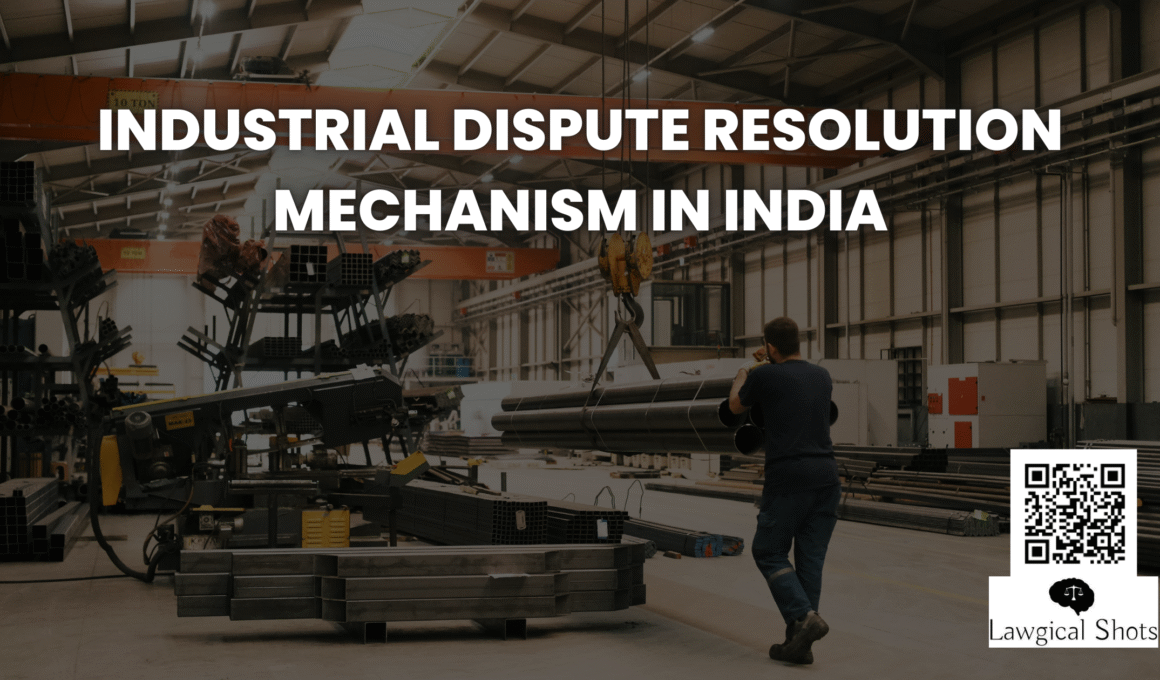Industrial relations lie at the heart of a nation’s economic and social stability. The relation between employers and employees is complex which is shaped not only by business interests but also by social, political, and economic forces. As industries in India expanded, especially after independence, disagreements between labour and management became increasingly visible. Issues related to wages, working hours, job security, workplace safety, retrenchment, and conditions of employment frequently triggered disputes.
If left unresolved, these conflicts can reduce efficiency, cause large-scale strikes or lockouts, and destabilise entire sectors of the economy. Historically, employers often held dominant power, while workers had limited opportunities to negotiate for their rights. This imbalance highlighted the need for a system of industrial jurisprudence that recognised labour as more than just a factor of production.
The Industrial Disputes Act, 1947 became a milestone in this direction. It sought to protect workers, prevent exploitation, and provide structured mechanisms to resolve disputes fairly. This article will explore the meaning of industrial disputes, their classifications, methods of resolution, challenges within the system, and landmark judicial decisions that have guided industrial relations in India.
What is an Industrial Dispute?
The Industrial Disputes Act, 1947 defines an “industrial dispute” in Section 2(k) as any dispute or difference between employers and employers, or between employers and workmen, or between workmen and workmen, which is connected with the employment or non-employment or the terms of employment or with the conditions of labour. This definition ensures that both individual and collective conflicts may fall within its scope, provided they concern industrial employment.
Certain conditions are essential for a matter to qualify as an industrial dispute:
1. Beyond a difference of opinion: The dispute must involve a real and substantial conflict and not a just disagreement in thought.
2. Proper documentation: The commencement date of the dispute and the demands should be formally recorded, usually by a trade union. In Union of Journalists v. The Hindu, the court observed that for a dispute to be claimed under industrial dispute, the same should be existing or apprehending on the date that has been referred. What the court meant by this observation is that if the demand by the employees were not brought before the management under which they work, and similar demands were raised during the time of the proceedings, the dispute will still be considered as an industrial dispute and proceed further with settlement mechanisms.
3. Collective significance: The dispute should affect a group of workers, not merely an individual. However, even a problem faced by individual may qualify if supported by a larger body of workmen.
4. Connection to employment: The conflict must directly affect the terms, conditions, or continuity of employment. Through these safeguards, the law ensures that disputes considered under the Act are genuine industrial conflicts with broader implications.
Check the Overview of New Labour Codes
Types of Industrial Disputes
Industrial disputes arise from diverse causes and may be categorised into the following types:
1. Interest Disputes
These are economic disputes relating to claims over wages, allowances, working hours, or bonuses. For example, workers may demand higher wages for work during inflation, while employers may reduce wages due to increased production costs. Such disputes directly affect financial arrangements and are among the most frequent causes of strikes.
2. Grievance Disputes
Grievance disputes arise when individual employees feel they are being treated unfairly. Common issues include wrongful dismissal, denial of promotion, biased disciplinary action, or violation of service conditions. Though they may begin at an individual level only, but if left unresolved it can gain collective support, leading to disputes on a larger scale.
3. Unfair Labour Practice Disputes
The Act prohibits unfair labour practices such as exploiting employees for union activities, discriminating in hiring or promotion, or unions forcing employers. Such practices weaken the trust and relations of employer and employee, and can escalate into long-term legal conflicts.
4. Recognition Disputes
These disputes concern the recognition of trade unions. When multiple unions exist in an establishment, conflicts arise most of the time over which union legitimately represents the workers. Similarly, sometimes employers may refuse to recognise unions, delaying collective bargaining.
Mechanisms for Industrial Dispute Resolution
The Industrial Disputes Act, 1947 establishes several mechanisms for resolving disputes. These mechanisms provides a combination of preventive approaches, which stop conflicts before they escalate, and curative approaches, which provide legal remedies once disputes have already arisen.
1. Works Committee
The Works Committee, composed of representatives from both management and workers side, functions as a preventive mechanism. It discusses various matters such as working conditions, health, safety, and welfare. By providing a direct channel of communication, the committee helps resolve minor issues before they grow into a major dispute.
2. Conciliation
Conciliation involves the intervention of a third party which is neutral for both parties, usually a government appointed officer, who facilitates discussions between the disputing sides.
• Conciliation Officers investigate disputes, organise negotiations, and help the parties reach a compromise.
• Conciliation Boards consist of an independent chairperson and equal representation from employers and workers. Their role is to promote dialogue and suggest acceptable solutions.
Conciliation does not impose decisions directly but encourages voluntary settlement, which makes outcomes more acceptable.
3. Voluntary Arbitration
Section 10A of the Act allows disputes to be referred to an arbitrator when both parties agree. The arbitrator hears both sides and delivers a binding award. In Gujarat Steel Tubes Ltd. v. Gujarat Steel Tubes Mazdoor Sabha, the Supreme Court enhanced the authority of arbitrators, equating their powers with those of labour tribunals. Arbitration is often faster and less formal than court proceedings.
4. Court of Inquiry
Under Section 6, the government may set up a Court of Inquiry to investigate the dispute and submit reports. While the findings of this court are not binding, they provide valuable insights for policy formulation and may help prevent future conflicts.
5. Adjudication
When disputes cannot be resolved by amy negotiation, conciliation, or arbitration, they may be referred for adjudication. The act provides three levels of adjudication:
• Labour Courts (Section 7): It handles disputes related to wages, hours of work, or unfair labour practices.
• Industrial Tribunals (Section 7A): It deals with matters such as layoffs, retrenchments, or closure of establishments.
• National Tribunals (Section 7B): It decide cases of national importance or those including more than one state.
These bodies have binding authority which ensures enforceable settlements.
Challenges in the Resolution Process
Despite a comprehensive legal framework, several challenges undermine the effectiveness of dispute resolution mechanisms in India:
• Bureaucratic Delays: Governmental red tape and huge judicial backlogs slows down the settlement of disputes.
• Resource Limitations: Many labour courts and conciliation offices suffer from inadequate staffing and infrastructure which leads to delay in dispute resolution.
• Outdated Provisions: Provisions of the 1947 Act often fail to keep pace with the changing industrial practices due to modernization and globalisation.
• Lack of Awareness: Workers in many unorganised sectors frequently remain unaware of their legal rights and keeps getting exploited.
• Political Interference: In many high profile cases political influence sometimes distorts fair resolution of disputes.
• Negative Relations: Deep-rooted mistrust between employers and workers unions may obstruct cooperation and prolong disputes.
Landmark Judgments on Industrial Dispute Resolution
The judiciary has played a significant role in interpreting and strengthening industrial dispute resolution.
1. Workmen of Hindustan Lever Ltd. v. Hindustan Lever Ltd. – The court observed that for every industry it is a necessity to promote harmonious construction of the wants of both the employer and the employee of an industry for the growth and prosperity of that industry and it’s labour force in long term. In order to attain this objective, the court laid down that there is a need for compulsory adjudication for resolving industrial disputes by means of a forum where the parties can resort for arbitration to avoid any kind of confrontation between them in the industry. The courts have repeatedly made it clear that although a lot of powers have been vested over an appropriate government, he cannot misuse such power in carrying out the procedure of settlement of disputes.
2. Gujarat Steel Tubes Ltd. v. Gujarat Steel Tubes Mazdoor Sabha – The apex court settled that judicial legislation vested upon the arbitrator the powers of a labour tribunal for cases of discharge of workmen as a form of punishment. This provided the arbitrator with appellate jurisdiction using which the arbitrator can oppose the decision of an employer regarding his employees.
These exceptional powers were conferred by the Supreme Court of India on the arbitrator.
3. Hochtief Gammon v. State of Orissa – The court in this case was of the opinion that the courts will have the authority to view that the action taken by the executive is not unlawful and unfair in nature and in this process the courts’ vests the duty of ensuring that the relevant matters of the dispute have been taken into concern in a large away while making a decision on the appropriate government.
4. Bangalore Water Supply v. A. Rajappa – Defined the term “industry” under the industrial dispute act, 1947 introducing a triple test to determine if an organization is an industry or not, thereby extending the protection of the Act to more workers.
These cases underline the judiciary’s role in balancing rights and ensuring fairness in industrial relations.
Conclusion
Industrial disputes are inevitable in dynamic economies, but their resolution determines the overall stability and progress of industries. India’s Industrial Disputes Act, 1947 provides a structured framework combining conciliation, arbitration, and adjudication to safeguard fairness and maintain peace.
Although challenges such as delays, outdated provisions, and strained relations persist, continuous reforms and judicial oversight have kept the system relevant. A well-functioning dispute resolution mechanism not only ensures justice for workers and employers but also contributes to higher productivity, sustainable growth, and social harmony. In the era of globalisation and rapid technological change, strengthening these mechanisms is essential for inclusive and balanced economic development.
This is a guest post submitted by Mr. Kunal Dagar, who is a student of law at NLU Sonipat.








